Introduction
If you care about your SEO. You need to attack it with a plan. Without a well implemented strategy you will be shooting in the dark and placing the fate of your website’s performance in organic search at risk. How do you combat this? With a high performance SEO content calendar that is designed to help you stay organized and help you reach your target audience as effectively as possible.
In this article by the Cindtoro team we will teach you the best practices behind creating a content calendar for SEO so you can ensure that your search engine marketing efforts are aligned with your goals.
Who This Guide Is For
This guide is specifically made for marketers, SEO professionals, content teams and business owners who are looking for the best ways to reach their target audience, stay on track and produce the highest quality results.
What Makes The Cindtoro Guide Different From Other Guides?
We created this guide with the latest and greatest most up to date information possible. We cover the advanced topics you need to know about plus how to use artificial intelligence to assist you with optimizing your content creation strategy. The strategies we lay out here are tested and proven to work if you follow them as they are laid out.
What Is an SEO Editorial Calendar?
An SEO Content calendar is a document that will outline the posts / articles that you or your company should be producing to create the most success possibleS on Google. It will typically display the types of content, publishing dates, post titles / meta descriptions and which team members are in charge of each task required.
The use of a SEO editorial content calendar plays a major role in ensuring that you do not repeat posts / articles you have previously published and are inline with your company’s overall SEO strategy as a whole.
Key Differences From A Regular Content Calendar
The key difference is an SEO content calendar only deals with performance on Google search or other search engines and will not involve any other asset. Whereas a “regular content calendar” could include items such as social media posts, videos, or other marketing assets for the overall marketing campaigns of your company.
How an SEO Editorial calendar aligns efforts with business objectives
A well designed calendar will help inform the content creation process and will help you stay aligned with your business objectives. If you do not plan for something you cannot take steps to either make it better or mitigate any negative effects. The calendar helps you see the full picture and identify any gaps you may have with your strategy.
Why You Need A SEO Content Calendar in 2025
SEO Content Calendar Benefits
Create Consistency
An SEO content calendar will allow you to create the level of consistency that is needed to achieve professional SEO results. SEO in particular requires a detailed and consistent effort in order to be successful and it does not work if you attempt to take the lazy way by not planning.
Drive Organic Visibility
If you produce content like the professionals would you will get professional level visibility.
This requires that you maintain your level of consistency with your content creation efforts. Google is filled with low quality content that fails to drive any SEO visibility at all this can be fixed by following best practices of SEO and Googles guidelines.
Increase Brand Authority
By staying aligned with your overall goals and content production habits you will be on your way to increased brand authority. This means you will have a much easier time ensuring that your company appears ahead of your competition. Authoritativeness in SEO is a critical part of establishing Google’s EEAT (Experience, Expertise, Authoritativeness, and Trustworthiness) A framework used by Google’s search quality raters to assess the quality of content and websites
Key Content marketing stats (fresh 2025 data)
- Did you know that content marketing revenue will reach 107 billion in 2026.
- Nearly 80% of small business owners and marketers report writing content themselves
- 43% of small business owners are planning to invest more resources into their website’s performance
Real-life examples of companies crushing it with SEO content calendars
Some of the best examples of companies who do an excellent job with their content marketing calendars are SEMrush and HubSpot. These two companies are notorious for running well oiled machines. They are also two of the largest brands in the digital marketing community. Their approach to content creation is systematic and well thought out which give them a competitive advantage in the software as a service space.
Creating A Strategic Foundation Before You Plan
A professional level SEO content calendar requires a strategic plan and foundation. There are a number of steps we are going to walk through in this section. Goal setting, understanding your audience and how to align your content with your brand.
Define goals (What are you looking for) traffic, leads, rankings, engagement
Goal setting is one of the most important elements you will need to do. Without setting quality goals you will significantly limit your results from your SEO efforts. Defining a goal can come down to identifying how much traffic you are looking to gain, what rankings you would like to improve and what type of website engagement matters most to your business.
Knowing your audience
Understanding your audience comes down to two different key things: SEO content personas and customer journey mapping. These two things are the foundation of understanding your audience. Without mapping out these two elements it will be very difficult to create your strategic foundation.
SEO Content Personas
Audience personas help you identify who your ‘ideal customers’ are by creating examples of the different types of target audiences you want to attract using your content marketing strategy and will help you understand the types of content you will need to use to reach them from your website. An audience persona will vary from website to website based on how large the pool is for a businesses target market. As an example VPs of marketing will need a different content approach than a woman in their 20s looking for cosmetic products.
A persona will include things such as:
- Interest
- Demographics
- Thoughts
- Needs
Interests
Encapsulates both personal and professional interests, they tend to overlap. A great question to ask yourself is: what is your persona interested in, both professionally and personally? Interest could include things such as hobbies (fitness, travel), business habits (an interest in productivity tools), or topics a user may be interested in (sports, news, healthy living).
Demographics
Demographics include things such as age, gender, relationship status, and family setup relevant to your product or services. A best practice is to only add demographics that directly correlate to your product or service.
As an example: for a sock company, ethnicity doesn’t matter, but for a line of hair products for African-American hair, ethnicity does matter.
Thoughts
To create a winning persona and match your SEO content to your target audience as best as possible you need to get into the mind of your ideal customer profile. To do this you can ask yourself questions that draw out your persona’s opinions, values, lifestyle, or business goals. As with demographics, be sure to stick to only “thoughts” that are applicable to your brand.
Needs
This step involves understanding what your ideal customers needs
What are your personas looking for? How can your company meet their needs? How does it stand apart from what competitors are doing? Outlining this information can help you understand a persona’s thought process and overcome any objections to product or service offerings.
Customer Journey Mapping: Aligning brand voice, messaging, and funnel stages
You should have a plan to align your brand’s voice, message and funnel stages with various different types of SEO content. Every post / article you create should be thought of carefully in order to avoid overlap and to produce the end result you are looking for.
To do this you will need to think about how your content should be read?, what your overall message is? and how many stages of the funnel will you need to cover prior to pushing a user to make a purchase?
Smart Keyword Research + Topic Mapping
A key component of your SEO content content calendar is proper keyword research and topical mapping. Without this step you will decrease your ability to attract the right audience to your website. It’s 2025 there are a lot of advanced SEO tactics you should be using to do this.
How To Use AI tools Like Semrush/Ahrefs for intent-driven clusters
Keyword research tools like Semrush / Ahrefs have adopted the use of AI that can assist with the creation of high quality keyword research list that can be used to create your overall topical map. The process to create intent driven clusters using their AI features is relatively simple. We are going to walk you through how to do this to do this using SEMRush. If you have Ahrefs the process will likely be the same.
Step One
Log into SEMRush

Step Two
Navigate to the “keyword strategy builder” section of the tool

Step Three
You should see a screen that looks like this. Next go to the input box and type your keyword you want to create content around.
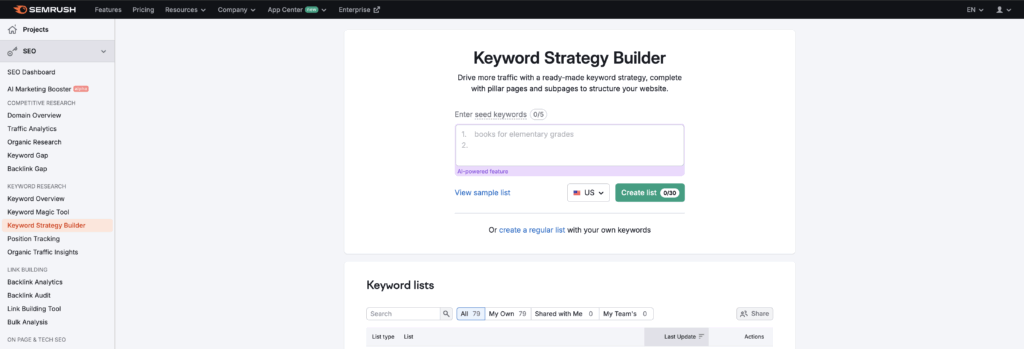
Step Four
The tool will automatically create intent driven clusters you can use to create content around. You will need to give the tool some time to pull the data be patient.
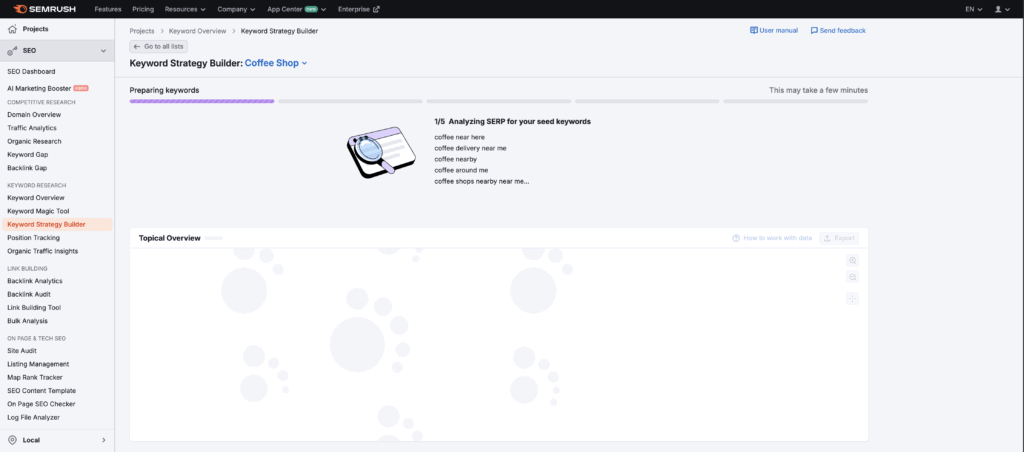
Semantic SEO and Topical authority
To achieve topical authority you need to employ the help of semantic SEO. This means you will need to write content on as many topics as you can. If this means you need 100 articles you need 100 articles. If you need more you need more… Topical authority can only be achieved by creating content on as many subjects as possible related to your industry.
Mapping topics to TOFU, MOFU, BOFU
When you get started with your keyword research process you should think about various parts of the SEO funnel. There are three different parts, top of the funnel, middle of the funnel, and bottom of the funnel, TOFU, MOFU and BOFU.
TOFU
Top of the funnel keyword should contain keywords sets that would warrant additional discovery. These would be terms such as “what is SEO” “how does SEO work”, “What Is Digital Marketing”
MOFU
Middle of the funnel topics will normally contain keywords that indicate more intent than a top of the funnel keyword strands but not enough to indicate a user is ready to use a product or service. These terms are keyword strands such as: Digital marketing benefits, how long does SEO take? And how does SEO benefit my business.
BOFU
Finally, we have a bottom of the funnel keywords. This is one of the most important part of your calendar. BOFU keywords indicate a user is ready to use a product or service. These keywords will be terms like: Digital Marketing Agency, Marketing Services, and SEO services provider.
BOFU keywords have the lowest search volume but the highest intent.
Content Types, Formats, and Frequency
Choosing formats based on intent & goals
Choosing the right type of content will come down to your search intent and goals. Are you creating a blog post, video, or product / service page? Knowing which one of these you need to make and how it aligns with your goals will make it easier for you to create a content schedule that fits your needs as a business.
Evergreen vs trending content
Have a plan to include both evergreen and trending content as part of your SEO content schedule. This will give you the best possible mix of traffic diversity. Evergreen content last a long time and normally does not have an expiration date as long as you update it every once in a while. Trending content on the other hand can give you a quick SEO boost if you write on a lower competition topic or you post often.
How Often To Publish
Speaking of posting content you should also outline how often you are going to publish. This step will help determine your cadence with how much content you will need to create on a daily, weekly or monthly basis to stay on top of the content production process. In the world of SEO more is not always better.
You should strive to create the best content that you can. This will give you the best possible chance to rank high in Google’s search results. Google takes quality seriously they do not want to be bogged down with low quality articles produced to manipulate they search rankings.
Using AI in Your Content Creation Process
At Cindtoro we understand managing an editorial calendar can feel overwhelming. AI tools give creators the ability to make that process smoother and more efficient.
Here is how you can use AI to stay organized, automate content planning, and create a workflow to keep everything on track.
How to Use ChatGPT for Your Briefs, Outlines, and Idea Creation

A huge challenge of SEO content creation is coming up with fresh ideas and figuring out how to structure them for maximum impact. ChatGPT and AI in general has come a long way since marketers started using it to help with task.
Step 1
The first part of the content creation process with AI is to come up with an idea. Start by providing a topic or a few keywords. You will want to keep the ideas things short and sweet so you do not confuse the system in order to give you what you are looking for. GPT will give you what you are looking for but only if you know how to ask the right questions this is where most people go wrong trying to implement AI into their business.
Prompt To Use
“GPT I am creating an SEO content calendar and need ideas. Suggest me 20 topically relevant ideas I can use to create content for [ PRODUCT, SERVICE OR IDEA ] “
In our example we will use coffee shops to illustrate our point.
If we are needing to generate ideas for a coffee shop. Our first step is to provide the prompt like so: “GPT I am creating an SEO content calendar and need ideas. Suggest me 20 topically relevant ideas I can use to create content for [ My Coffee Shop ] “
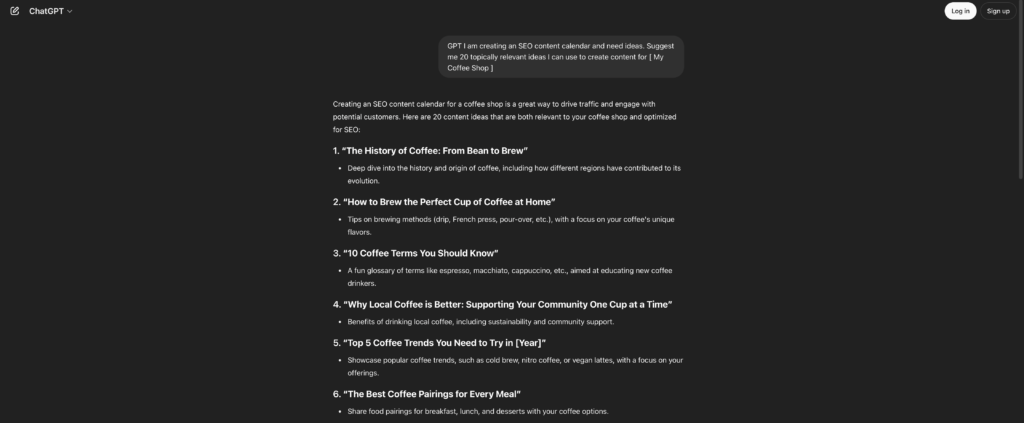
As you can see GPT will give you an outline as expected with ideas that you can use to create content outlines around your topic this brings us to the next part of the process.
Step 2
In step two of our process we will need to pick the article idea that we want to create an outline around once you have yours place the title into the placeholder and run the prompt below.
Prompt To Use
GPT please give me an outline I can use to create a content outline about [ INPUT GPT ARTICLE TITLE ] I want you to create this outline based on the top performing article on Google Search for my chosen topic I listed above. Produce an outline that is designed to beat their content and rank higher.
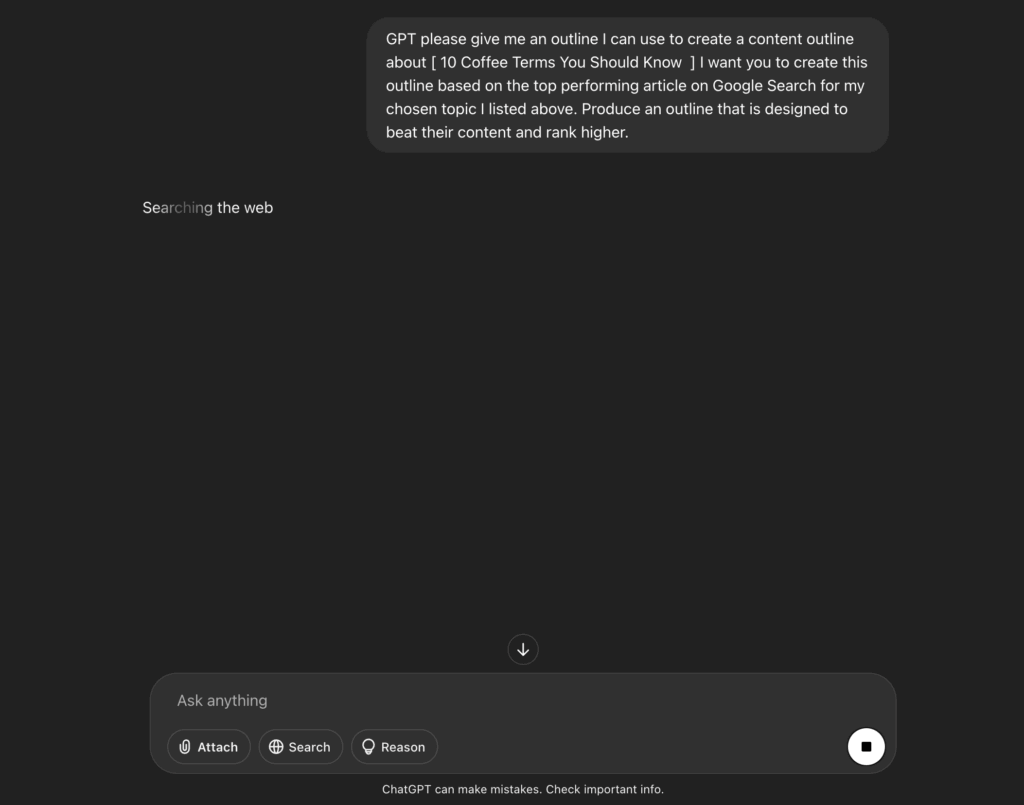
GPT will now search the web for the best performing article for your chosen topic to generate you an outline.
Step 3
In step three of the process you will be presented with the choice to have GPT write the article for you OR you take the outline and write it yourself.
We would recommend that you write it yourself because it will sound and read better than the AI version.
However if you want to use GPT to create your content we recommend you use the prompt below then read this article on ChatGPT and SEO so you do not harm your website.
Prompt To Use
“GPT take the outline you created me format it like the top performing webpage on page one rank one of Google. Write the entire article as if a human created it. Give as much description and depth as necessary”
Other AI Tools to Assist with the Content Creation Process
Notion AI
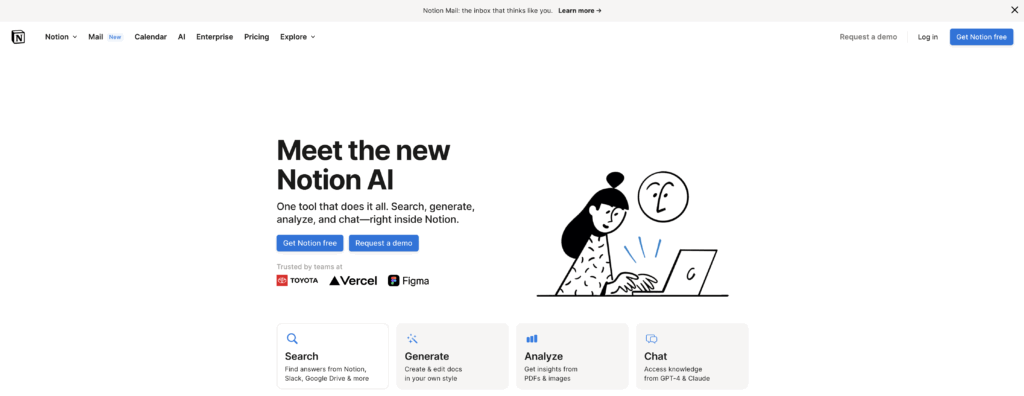
Notion AI will help you organize tasks, track deadlines, and come up with content ideas when you’re running low on inspiration follow similar steps as laid out above just sub the word GPT for Notion AI.
Jasper

Jasper can also generate high-quality content based on your outlines, so you’re not starting from scratch. This will help you save time having tp write the content yourself.
No matter which AI tool or tools you use they can help you to streamline your entire content creation process from idea creation to publishing so you can focus on what really matters: creating great content one article at a time.
Building the Calendar Step-by-Step
Building everything together is the final step of the process. Your first step will be how to define how you want to create your calendar.
Step 1
Start with a strong idea creation process. If you cannot think about any ideas or you need help. You should look at using either ChatGPT or the keyword strategy builder from SEMrush. Follow the steps we outlined to create the full content outline.
Step 2
Assign roles, set deadlines and create a content production workflow to stay organized and on track. This will help you define which one of your team members is in charge of what task and the date they need to get the tasks done by. If you are a one man (or woman) show this concept is still the same.
Step 3
Follow through with producing your content. Give it a thorough overview to ensure that it achieves your desired expectations and will achieve your company goals rinse and repeat as needed.
Mistakes to Avoid and How to Fix Them
Common Pitfalls
There are a few common traps you should be aware of if you are going to go down the road of creating a content calendar and enforce content production standards into your business.
They are:
- Publishing without a strategy
- Skipping updates
- Siloed teams
These things can be taken care of fairly quickly if you pay attention to the inner workings of your business. When you see you or your company deviating away from connect management practices put in place, guide yourself (or team) back to the unique process established for your business. This will help to avoid any pitfalls.
Conclusion
Prior to launching your SEO editorial calendar ensure it has everything on it you need to achieve your company’s organic search efforts. Ask yourself questions like does this content calendar align with my goals. Did I think of multiple areas of improvement? How thoroughly did we cover all the bases?
These sorts of questions will help ensure that you are well on your way to not only creating a great SEO content calendar but also one step closer to better Organic SEO traffic one post at a time!
We Recommend Reading:
URL Rapid Indexer Vs Search Console
Reasons Why Your SEO Does Not Work
How Do Blogs Help SEO & How to Make Them Better
FAQs
How often should I update my SEO calendar?
You should update your SEO calendar as often as required by the needs of your company. This may be daily, weekly monthly or quarterly. It all depends on the needs of your organization.
Can I use ChatGPT to plan my calendar?
You can use ChatGPT to plan your content calendar. Remember you will get out of GPT what you put in. Make your AI prompts detailed and ensure they are not confusing if so you may spend unnecessary time fixing the outputs of GPT to fit your needs.
